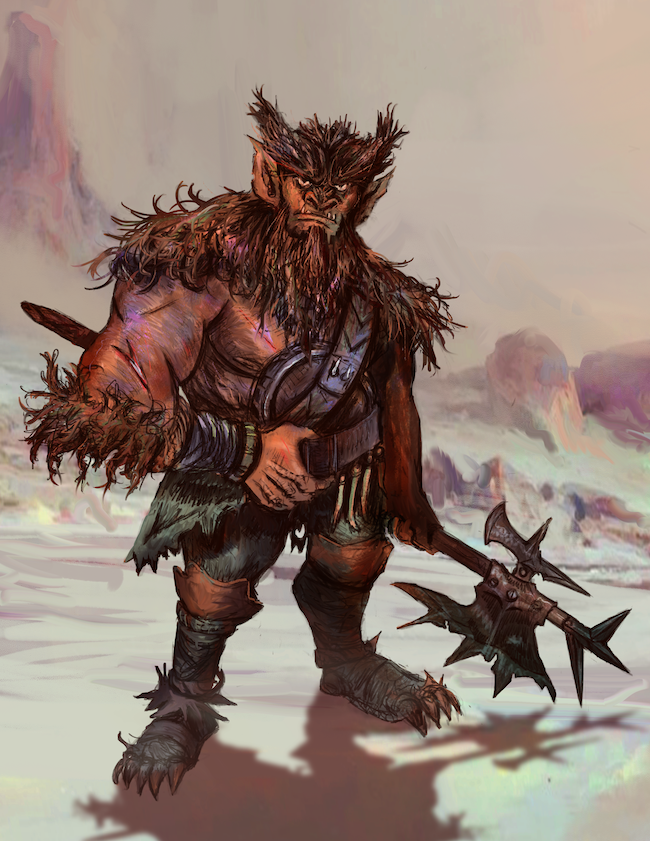
AC 12
HP 30 (5d8 + 8; bloodied 15)
Speed 30 ft.
Proficiency +2; Maneuver DC 12
Skills Athletics +4, Stealth +4 (+1d4), Perception +3 (+1d4), Survival +3 (+1d4)
Senses darkvision 60 ft., passive Perception 15
Languages Common, Goblin
ACTIONS
Strangle. Melee Weapon Attack: +4 to hit, reach 10 ft., one Medium or smaller creature that is surprised , grappled by the bugbear, or that can’t see the bugbear. Hit: 9 (2d6 + 2) bludgeoning damage, and the target is pulled 5 feet towards the bugbear and grappled (escape DC 12). Until this grapple ends, the bugbear automatically hits with the Strangle attack and the target can’t breathe .
Maul. Melee Weapon Attack: +4 to hit, reach 5 ft., one target. Hit: 9 (2d6 + 2) bludgeoning damage.
Javelin. Melee or Ranged Weapon Attack: +4 to hit, reach 5 ft. or range 30/120 ft., one target. Hit: 5 (1d6 + 2) piercing damage, or 12 (3d6 + 2) piercing damage if the target is a creature that is surprised or that can’t see the bugbear.
Stealthy Sneak. The bugbear moves up to half its Speed without provoking
opportunity attacks
. It can then attempt to hide.
Combat
A bugbear prefers to strangle an unaware opponent from hiding. It fights with its maul if it must, but when badly injured it uses its Stealthy Sneak to reach a hiding spot and then either attack with its javelin or strangle a passing creature.
Names
Bruggek, Gashk, Gnashtooth, Groar, Hrak, Hrorr, Redclaw, Sturg
Legends and Lore
With a History or Nature check, characters can learn the following:
DC 10 Bugbears are stealthy hunters and trackers.
DC 15 Some bugbear tribes are feared raiders, and others are valued as mercenaries and bodyguards.
Bugbears are rangy, hairy creatures related to goblins. Nimble and quiet for their size, they are stealthy ambushers and relentless hunters. Along the margins of settled land, the word “bugbear” has become synonymous with hidden terrors lurking in wait.
Fearsome Hunters. Bugbears are skilled trackers and trappers. Despite their size and strength, they rarely attack openly. They strike from hiding; their prey often dies without ever knowing it was being stalked. Bugbears’ silent combat efficiency makes them sought after as scouts and mercenaries, and some bugbears make good livings in cities and war camps. Few forest villages open their gates to a bugbear traveler, however—bugbear raids are the stuff of nightmares.
Goblins. Bugbears are related to goblins and hobgoblins and are sometimes found among them. Bugbears are strong enough to rule over goblins, but in a disciplined hobgoblin force they are relegated to the role of scout and ambusher.
1 On the hunt
2 With a prisoner in a sack
3 Hiding in ambush
4 Looking for mercenary work
5 Scouting for a larger force
6 Looking for a new home after tribe was defeated
7 Owed money by a former boss, and mad about it
8 Working as mercenaries for a nearby faction; wearing breastplate (AC 16)
1 DC 14 Perception check: clump of coarse brown fur caught on something sharp
2 The corpse of a human soldier or bandit, strangled and robbed; DC 14 Perception check discovers big footprints leading away
3 An extinguished campfire
4 A hunting trap (DC 14 to spot)
Bugbears thrive in any environment.
CR 0–2 1 or 2 bugbears
CR 3–4 3 or 4 bugbears ; bugbear with 4 to 6 goblins
Treasure 250 gp, 600 sp, potion of climbing , potion of healing
CR 5–10 Bugbear chief with 1d4 + 2 bugbears ; 2 or 3 bugbears with 1d4 + 3 goblins riding wolves
Treasure 700 gp, 1,200 sp, 5 bloodstones (50 gp each), 4 potions of healing , gloves of missile snaring
Humanoids include a number of different intelligent, language-using bipeds of Small or Medium size. Humans and elves are humanoids, and so are orcs and goblins. Humanoids may employ magic but are not fundamentally magical—a characteristic that distinguishes them from bipedal, language-using fey, fiends, and other monsters. Humanoids have no inherent alignment, meaning that no humanoid ancestry is naturally good or evil, lawful or chaotic.
